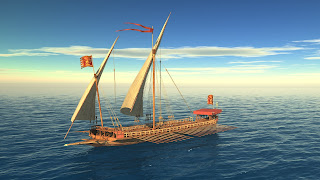Soon after the Roman Emperor Constantine embraced Christianity, in 312 AD, Jerusalem became a place of pilgrimage. Among the first to make the pilgrimage was his own mother, recognised by the church as Saint Helena. She travelled there in 326 AD, and was convinced that she had found Christ's tomb, and the remains of his cross. Her son would later finance the construction of a basilica on the site of her discoveries.
Chaucer's fictional "wife of Bath" had already made three pilgrimages to Jerusalem when she set out for Canterbury, but the journey in her day would have been a difficult and perilous one. By the end of the 15th Century, however, it had become easier. Venetian galley-owners had established an effective monopoly, liaising with the Muslim authorities in Palestine to smooth the journey. These were, in effect, Europe's first package tours.
A Venetian galley. Image: http://telias.free.fr (reproduced with permission).
Several travellers who made the journey in the late 15th and early 16th Century wrote accounts of their pilgrimages, and one of these was an English priest, Richard Torkington (the Vicar of Mulberton in Norfolk, a benefice dependent on Thomas Boleyn), who travelled in 1517. His was one of the accounts that I used to reconstruct the pilgrimage of Richard Mabon, in my novel, Omphalos (Mabon, like Torkington, was a historical pilgrim, but he left no record of his journey). Let us follow Torkington's journey, week by week.
Torkington sailed from Rye to Dieppe on 20th March, and made his way on horseback to Venice, via Paris, Lyon, Milan, Pavia and Ferrara. He witnessed the ceremonial marriage of the Doge with the sea.
The Doge's "Marriage with the Sea" - anonymous 16th Century miniature (image is in the Public Domain).
Here Torkington describes his departure, and the days that followed.
"Sunday after Corpus Christi Day, the xiiij of June, we departed from Venys in a little bott whych brought us to the shippe that lay iiij myle without the castellys, a good new shippe whiche mad never jorney a fore of viij C tunne. The name of the patrone was called Tomas Dodo."
Venice, by Bolognino Zaltieri, 1565 (image is in the Public Domain).
"Twesday the xvj day of June a bowt v of the clok in the morning, we mad sayle with scarce wynde."
"Thursday xviij June - Ruyne (the modern Croatian port of Rovinj), 110 miles from Venice - went ashore."
The back-streets of Rovinj, where Torkington may have wandered, stocking up on cheese, wine, fruit and cured meat for the on-going journey. Photo: Ivana (image is in the Public Domain).
"Midsomerday we passed by the most strong and mighty town called Aragousse (Dubrovnik) in the countrie of Slavanye or Dalmacie. They pay tribute to the Turk ... it is the strongest town of walls, towers, bulwerks, watches and wardes that ever I saw in all my lyffe."
The fortifications of Dubrovnik. Photo: Luna04 (licensed under GNU).
"Thursday after Midsom Day, about iiij of the cloke at aftyr noon we passed by Corfana (Corfu) ... At Corfana the patrone shewyd me the ... strong castellys, standing upon ij rokkys, they hold of the Venysyans."
The Venetian fortress of Corfu - 16th Century print. British Museum (image is in the Public Domain).
"Ffryday that was John's and Pauli we sayled with ese wyndestal, in alto pelage (on the high seas), levyng Grece on the left hand, and Barbary (North Africa) on the ryght hande."
At the end of their first week, Torkington and his companions had left the Adriatic Sea behind them, the galley turning eastwards towards the Holy Land.
More next week!
Mark Patton's novels, Undreamed Shores, An Accidental King and Omphalos, are published by Crooked Cat Publications, and can be purchased from Amazon.







How fascinating! Someone actually kept a diary of the trip!
ReplyDeleteThanks, Sue! Yes, he was one of several who did so. Others include an Italian priest, Pietro Casola, and German laymen, Bernhard von Breydenbach and Arnold von Harff. I shall have more to say about them in later blog-posts. My own character, Richard Mabon, seems not to have kept a diary (or, if he did, it hasn't survived), so I had to make it up, and the surviving accounts were invaluable to me in doing so.
ReplyDelete